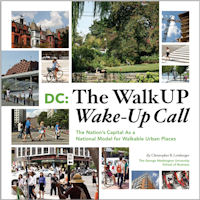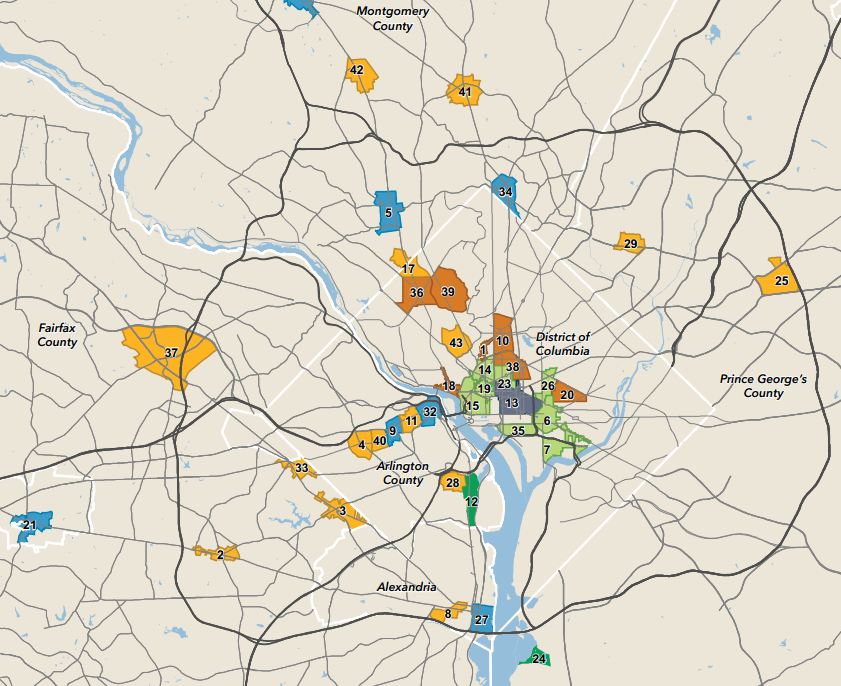 Momentum is shifting decisively from the traditional model of auto-centric development associated with “suburban sprawl” to WalkUps, the term that urbanist Christopher B. Leinberger has coined for Walkable Urban Places. Not only that, contends Leinberger in a new paper, “D.C.: The WalkUP Wake-Up Call,” but the Washington region stands at the vanguard of the national trend.
Momentum is shifting decisively from the traditional model of auto-centric development associated with “suburban sprawl” to WalkUps, the term that urbanist Christopher B. Leinberger has coined for Walkable Urban Places. Not only that, contends Leinberger in a new paper, “D.C.: The WalkUP Wake-Up Call,” but the Washington region stands at the vanguard of the national trend.
That may come as a surprise to those who know the region primarily for its hellish traffic congestion and developers’ voracious appetite for land. Despite its fearsome reputation for traffic gridlock, metropolitan Washington stands near the top of national surveys of walkability and the region has emerged since the 1990s as an example of how the nation should develop the built environment, Leinberger contends.
In the 1992-2000 business cycle, the share of office, retail, apartment and hotel property built in WalkUP neighborhoods was 24%. Between 2009 and the present, market share stood at 48%. In the future, predicts the George Washington University professor, WalkUps will continue to predominate as the market corrects for changing demographics and the excess supply of car-centered communities erected in previous building booms.
Leinberger defines six types of regionally significant WalkUPs: downtown, downtown adjacent, urban commercial, surburban town center, strip commercial redevelopment and greenfield. The Washington region is unique in the country for having all six types. He has identified 43 of these places, with the main concentration in the urban core of the District of Columbia but with a remarkable number (remarkable to me, at least) in Northern Virginia.

The 43 WalkUps are roughly 15 times more densely developed than the rest of the region. While accounting for less than one percent of the land mass, they account for one-third of the region’s employment. WalkUPs hold an even higher percentage of primary jobs (as opposed to local service jobs). These places are light on residential, contributing only three percent of the regional inventory. But the sales value per square foot for residential is 71% higher than for other areas. Likewise, office rent per square foot runs about 76% higher.
Leinberger ranks WalkUPs as copper, silver, gold and platinum, depending upon various walkability criteria including the presence of mass transit. Copper WalkUPs are walkable communities in the making where local governments have made necessary zoning changes and invested some of the required infrastructure but the private sector is only beginning to respond. Tysons Corner is an example of this type. Despite limited change, office leases go for a 4% premium, while housing price sales are 13% higher.
The Silver WalkUps in the Leinberger classification are 53% more dense than the Coppers and have 44% higher rents. The Golds have 19% higher rents than the Silvers, while the Platinums — downtown Washington, Georgetown — have 19% higher rents than the Golds.
Leinberger posits a strong connection between the average education level of a region’s workforce and its preference for walkable communities. Knowledge workers are driving the trend to walkable urban places. As the metropolitan region with the highest level of education in the country, he writes, Washington is “farthest along in adjusting to the demands of the knowledge economy.”
A rise in highly educated knowledge workers has powered the explosion in demand for and development of walkable urban places in metro D.C. and elsewhere. These highly educated creative class workers, especially the young Millennials (born between 1982 and 2004), want the option of living and working in walkable urban places. Since metro D.C. has relatively more of these workers than any other metropolitan area, it is not surprising that it leads the WalkUPs phenomenon. As these Millennials age, many seem to be moving to or near suburban WalkUPs, such as Arlington. When it comes to developing suburban WalkUPs, metro D.C. has a substantial lead over all other U.S. areas.
Bacon’s bottom line: I agree with Leinberger’s broad thesis, although I do think he pushes it too far at times. For instance, he entertains the possibility that walkable areas have greater social equity than other parts of town, thus creating a liberal-progressive trifecta of economic efficacy, environmental sustainability and social justice. The case is less than persuasive, as he reluctantly admits. The fact that walkable, mixed use areas command the highest premium for rents, house sales and office leases guarantees that only the most affluent members of society can afford to live and work there.
However, inequities could diminish if more WalkUps development occurs. The premium price for rents and leases stems from the relative scarcity of these places compared to the demand for them. Build enough and the premium will disappear.
In the meantime, all Virginians (including Northern Virginians) will have to look at metropolitan Washington very differently. Far from representing what’s worst and most dysfunctional about human settlement patterns, the region could be some 40 years ahead of other regions in adapting land use to the exigencies of the Knowledge Economy.
— JAB


